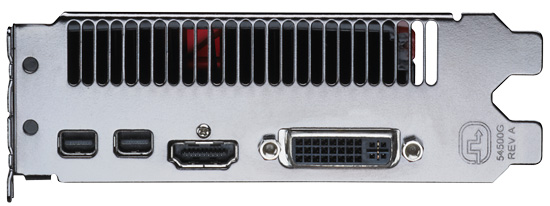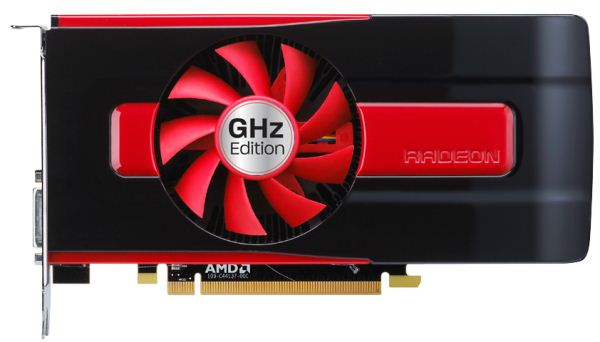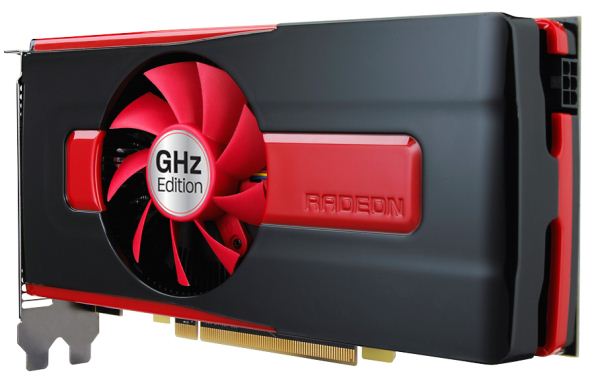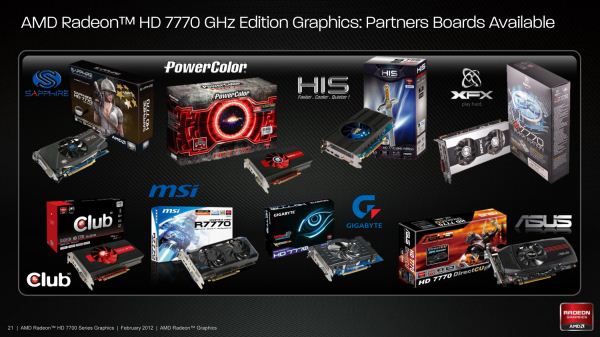AMD Radeon HD 7750 & Radeon HD 7770 GHz Edition Review: Evading The Price/Performance Curve
by Ryan Smith & Ganesh T S on February 15, 2012 12:01 AM EST- Posted in
- GPUs
- AMD
- HTPC
- GCN
- Radeon HD 7000
Meet the Radeon HD 7770 GHz Edition
The second card launching today is the Radeon HD 7770 GHz Edition. Compared to the 7750 it’s based on a fully enabled Cape Verde GPU and features a higher core clock of 1GHz, versus 800MHz on the 7750.
Starting as always with the cooler, for the reference 7770 AMD has gone with something that is best described as half of a blower. The shroud is completely enclosed on the sides, but due to the position of the fan the card exhausts hot air out of both the front and the rear of the card, which is something that’s common for dual-GPU cards such as the 6990 but atypical for a midrange video card. Heat transfer is provided by a basic black aluminum heatsink, while the fan is embedded in the middle of the heatsink.
As for the card itself, it’s effectively an extended version of the 7750. Like the 7750 the card is equipped with 4 256MB 5GHz Hynix GDDR5 RAM chips, along with some additional VRM circuitry to handle the higher 100W power limit for this board. External power is provided by a single 6pin PCIe power socket, while at the top of the card there is a single CrossFire connector. This is actually down from 2 connectors on the 5700 series, which comes as no great surprise as virtually no one ever used tri-CF with the 5700 series in the first place. Overall the card is 8.25” long with no notable shroud overhang, making it the same length as the 5770’s PCB.
Meanwhile for display connectivity AMD is using the same configuration as we’ve seen on the 7900 series: 1 DL-DVI port, 1 HDMI port, and 2 miniDP ports. Unlike the 7900 series AMD’s not requiring their partners to include any adaptors, so buyers with 2 DVI monitors will almost always be on their own. The presence of 2 miniDP ports means that the 7770 has quite a bit of flexibility in driving various displays, however as with the 7900 series if you want to drive more than 4 displays you will need a MST hub, the release of which is still some time off.

As for partner cards, as with the 7750 all of AMD’s partners are doing their own thing. No one will be using AMD’s reference cooler, though PowerColor in particular will be using a cooler similar to it. Everyone else will be using their own double-wide coolers, most of which will be open air as we typically see in this market segment. Like the 7900 series AMD is relying on the 7770 having some degree of overclockability, so there will be a number of factory overclocked cards taking advantage of this.
Finally, I wanted to quickly touch on the naming of the 7770. The official name of the 7770 is the Radeon HD 7770 GHz Edition; with the last bit being AMD’s latest marketing push. Starting with the 7770, AMD is going to be branding every card with a reference clock at or above 1GHz as a “GHz Edition” card to capitalize on the fact that they’ve hit 1GHz. Thus in spite of what the name implies there won’t be a 7770 non-GHz Edition card, as it’s a tagline rather than a true suffix necessary to differentiate cards.
With that said, while hitting 1GHz on a GPU is a notable accomplishment for AMD and should not be ignored, it’s not going to be particularly important in the grand scheme of things. The embarrassingly parallel nature of rendering means that GPU performance isn’t nearly as tied to clockspeeds as CPU performance is, as you can always lay down more functional units to improve performance. Clockspeeds do need to go up over time due to the limited parallelization of the command processor, but otherwise GPU performance has never been heavily dependent on clockspeeds.



















155 Comments
View All Comments
Articuno - Wednesday, February 15, 2012 - link
Kepler really, really needs to come out soon, and I'm saying this as an AMD fan.Malih - Wednesday, February 15, 2012 - link
Exactly, I'm a fan of AMD myself, and I can't wait for Kepler, AMD needs a kick in the (you know what)DimeDeviL - Wednesday, February 15, 2012 - link
"Theoretically the 5770 has a 5% compute performance advantage over the 5770."eminus - Wednesday, February 15, 2012 - link
uhhh really? same card performs better hehehehetynopik - Wednesday, February 15, 2012 - link
lobbing off -> lopping offmattgmann - Wednesday, February 15, 2012 - link
I feel like reviewers were blinded by performance with the 7970/7950 cards. They offer the same lack of competitive pricing as these lower end cards. The 7950 can be compared directly (in price and performance) to the Nvidia GTX 580, a card that was available a year ago.I'm still rocking a pair of 4870s that set me back ~$400 a few years back. To get a substantial performance upgrade, I'd have to spend $450 on a 7950 today. Where is the value in that? Yes, power consumption and features are important but are tertiary to raw performance in almost every user scenario when it comes to gaming.
To say the least, the lack of competitive pricing between nvidia and amd currently smells a little fishy.....it wouldn't be the first time there was price fixing in the graphics card industry.
maniac5999 - Wednesday, February 15, 2012 - link
I'm convinced that the pricing for 4870s in late 2008/early 2009 was the sweet point to buy. Yes, power consumption sucks, but other than that, a card that cost me $160 then, is pretty competitive with a card that costs $120 today. I think we may have just lucked out with the 4870s, and may need to wait until at least Kepler, if not 8XXX to upgrade.chizow - Wednesday, February 15, 2012 - link
Just be careful not to set expectations on the 4870's pricing for 2 reasons:1) 4870 pricing was a mistake imo. AMD will say it was a calculated one in fluff pieces like the RV770 story and it was true in some degree that AMD needed to recover mindshare/marketshare and consumer confidence after the R600 debacle and a weak performing RV670. Still, when you set your single-GPU flagship at $300 and your second SKU at $200, there's not much room to go down on pricing.
2) Late 2008 early 2009 was the height of the recession. Wall Street, Real Estate, Auto Industry, all that. Nvidia and AMD were feeling it too and got involved in a highly publicized price war. That's why you saw "new" high-end performance parts like the 4890 and GTX 275 launching for $230-$250 that occupy the $350+ market today, with cards like the 4870 and GTX 260c216 selling at tremendous value for $150 or less.
Its obvious AMD is doing its best to correct their 4870 price mistake over the last few years, but with the overall performance of Southern Islands stack, the 7-series was the wrong time to do it. They should've just stuck to their old pricing scheme or at worst, matched Nvidia's pricing ($500, $380) with their Tahiti parts. Then you might see the rest of the stack priced reasonably.
Zoomer - Wednesday, February 15, 2012 - link
Yeah, at this point of the business cycle, it sucks to have to buy anything. Everything is expensive due to all the capacity cuts.Recessions are good (for buying things, cars, houses, whatever). Btw: Housing is an anomaly due to efforts to stop/slow the process.
Oxford Guy - Wednesday, February 15, 2012 - link
Recessions are good for the rich... not so good for everyone else.